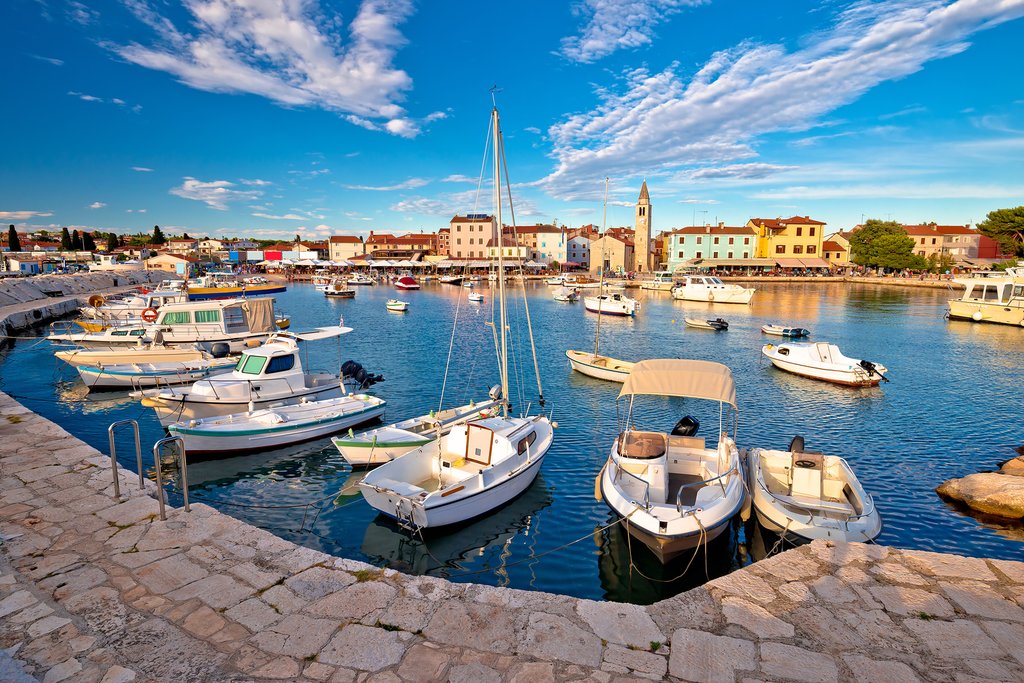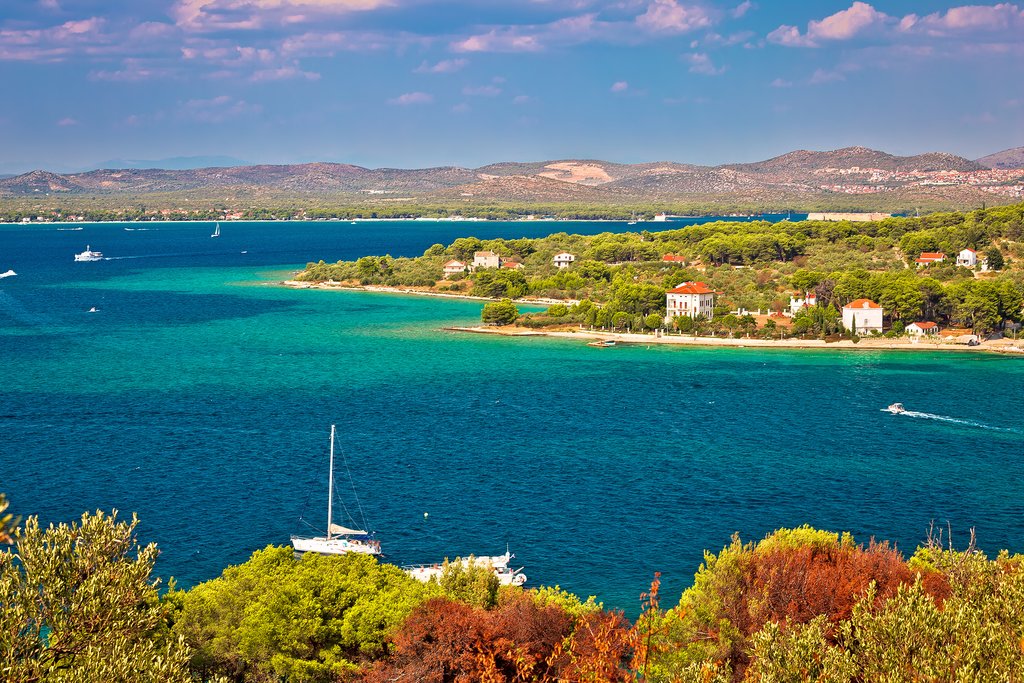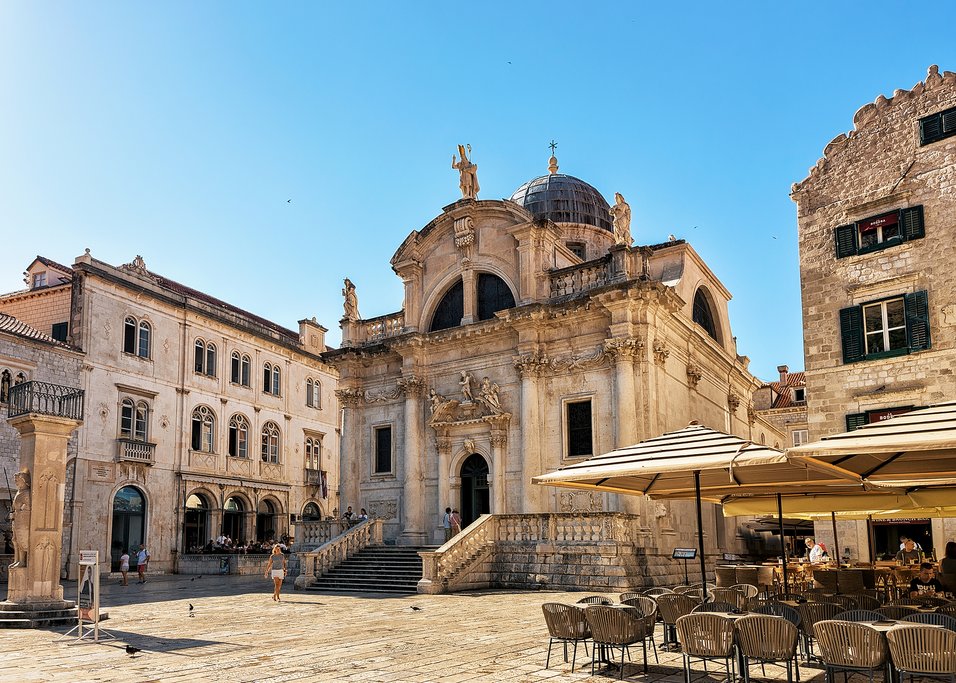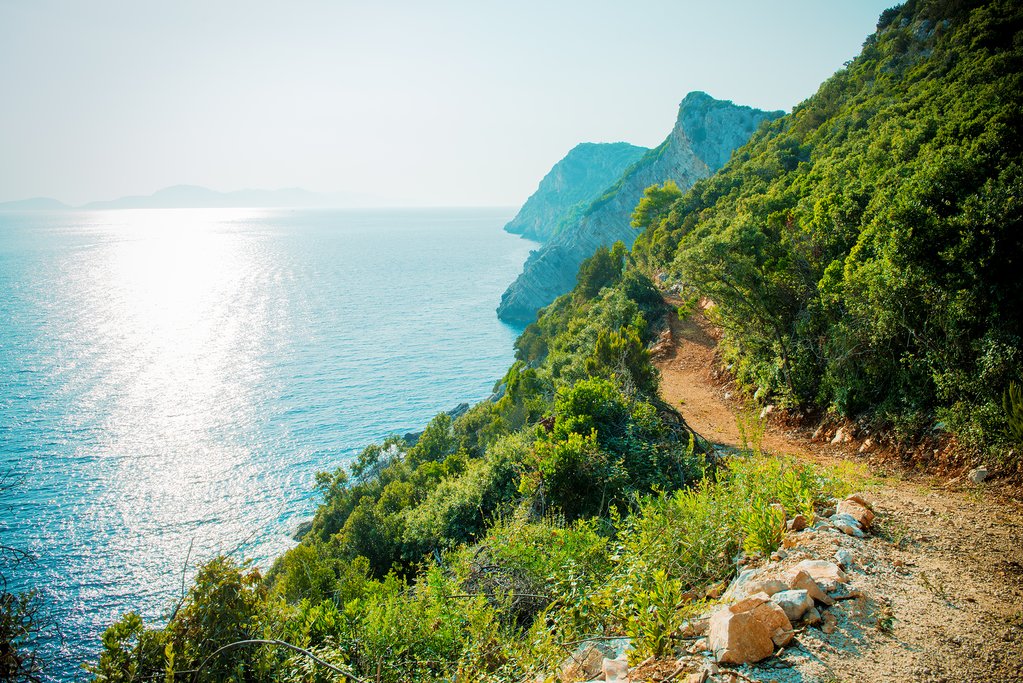Highlights
- Explore Zagorje and visit the straight-out-of-a-storybook Trakošćan Castle
- Hunt for mushrooms alongside truffle-sniffing dogs in Istria
- Find your very own slice of beach on Zlarin Island
- Swim in the emerald-green lagoon of Krka National Park's Skradinski Buk waterfalls
- Snorkel a sandy-bottom cave and cliff jump off the island of Šipan
Brief Itinerary
| Day | Highlights | Overnight |
|---|---|---|
| Day 1 | Welcome to Zagreb! | Zagreb |
| Day 2 | Scenic Castles of the Zagorje Region | Zagreb |
| Day 3 | Zagreb to Rovinj, Stopping at Plitvice Lakes National Park | Rovinj |
| Day 4 | Truffle Hunting in Motovun Forest | Rovinj |
| Day 5 | Coastal Istria: Fažana & Brijuni National Park | Rovinj |
| Day 6 | Sun & Relaxation in Cape Kamenjak | Rovinj |
| Day 7 | Rovinj to Šibenik, Stopping at Zadar | Šibenik |
| Day 8 | Beaches & History on Zlarin Island (Day Trip from Šibenik) | Šibenik |
| Day 9 | Explore Šibenik, Dalmatia's Most Underrated City | Šibenik |
| Day 10 | Krka National Park (Day Trip from Šibenik) | Šibenik |
| Day 11 | Šibenik to Dubrovnik, Stopping in Split | Dubrovnik |
| Day 12 | Walking Tour of Dubrovnik | Dubrovnik |
| Day 13 | Elafiti Islands by Private Speedboat: Kayaking, Swimming, & Villages | Dubrovnik |
| Day 14 | Cook Like a Local in the Konavle Region | Dubrovnik |
| Day 15 | Depart Dubrovnik |
Detailed Itinerary
Day 1: Welcome to Zagreb!

Start your adventure from Zagreb, the capital of Croatia. Upon arrival at the airport, you'll be transferred to your hotel to settle in. The rest of the day is yours to spend as you like. The city center is easily walkable and the streets and parks are easy to navigate by foot. All the main attractions and restaurants are within walking distance.
A gem of a European city, Zagreb is at once historic and new. It's filled with leafy green parks and gothic/neo-renaissance buildings, yet there's also modern shopping complexes, outdoor malls, and endless dining and drinking options. Consider heading out on a guided walking tour of the historic heart of the city. This involves walking from Ban Jelačić, the main square, to Zagreb's Upper Town and passing through local markets before reaching St. Mark's Square.
Alternatively, you can visit one of the many museums and art galleries, like the Homeland War Museum, the Nikola Tesla Technical Museum, or the ever-popular Museum of Broken Hearts. Or stroll through the city center, enjoying 17th-century neo-baroque architecture found at Zagreb's Art Pavilion and Croatian National Theater.
Zagreb also has a number of beautiful city parks which are great for exploring and people watching, especially in the late afternoon. Maksimir is a great option, with a variety of cafés nearby to pick up a coffee for your stroll.
Day 2: Scenic Castles of the Zagorje Region

Just a few miles northwest of Zagreb lies Zagorje, a bucolic hilly region, dotted with Renaissance and medieval fortresses, numerous baroque castles, and family-run vineyards and farms. It's a memorable, romantic landscape that will take you back in time to a sense of both the aristocratic past and the rural traditional way of life that still exists in Croatia today. A quick day trip from Zagreb allows you to immerse yourself in this beautiful region.
Find your way to Trakošćan Castle, a good example of one of these storybook locales, as it sits perched on a hill adjacent to a glassy lake. The castle, a historic landmark, was built in the 14th century as a defensive fortress but was later used as a home for aristocratic Croatian families. On a tour, you can not only visit the castle grounds but you'll go inside and explore all four floors, which function as a museum with permanent exhibitions.
Afterward, visit Veliki Tabor Castle, which is located just southwest of Trakošćan. This gothic-renaissance castle dates to the 16th century and also sits on a green hill overlooking the fertile countryside. It was originally built for a noble Hungarian family and its fortifications were designed to defend against Turkish invaders. A tour of Veliki includes visits to the towers, guardhouses, and inner courtyard plus a small museum featuring exhibitions of medieval artifacts like armor, weapons, and paintings.
Apart from castles, explore nearby old villages, like Kumrovec, where you'll find restored peasants' houses from the 19th century. These are great areas to browse local craft shops and enjoy some traditional country cuisine like grilled lamb, meat skewers, and veal stuffed with cheese and ham. Kumrovec is most well known for being the birthplace of Marshal Josip Broz Tito, the communist revolutionary who was President of Yugoslavia from 1953 to 1980.
Day 3: Zagreb to Rovinj, Stopping at Plitvice Lakes National Park

Get an early start this morning to make the scenic drive west to Rovinj, stopping first to explore Plitvice Lakes National Park, one of Croatia's most popular national parks. A must-visit for any traveler to Croatia, the UNESCO-protected park is comprised of an exquisite collection of 16 glassy emerald green and blue travertine lakes, more than 90 cascading waterfalls that seemingly cover every corner of the park, and numerous caves. The terraced lakes are surrounded by beech and pine forests and are home to extensive wildlife.
Here, you can request a private, expert local guide to lead you throughout the park along the wooden paths and bridges to show you the most impressive points of interest and explain the significance of its history and natural features. After your tour, you will have free time to continue exploring, have lunch, or you may wish to bring a bought lunch (and a bottle of wine!) with you to enjoy a picnic.
When you're finished in the park, continue on to Rovinj where you'll settle into your accommodation before taking the rest of the afternoon and evening to explore this small jewel on the west coast of the Istrian Peninsula.
Though Rovinj remains an active fishing port today, it wasn't until 1763 that it became part of the mainland. As such, its restricted access resulted in the labyrinth of narrow, cobblestoned streets you see today. Explore Old Town and marvel at the centuries-old Venetian influenced architecture as you pass under archways, through alleyways, and up stone stairwells. Navigate your way to Balbi's Arch and the 12th-century Town Clock, noting Rovinj's skyline dominated by the baroque St. Euphemia Church.
Seek out your choice of interest from churches to galleries and pebbled beaches, capping off the day with a delicious dinner of fresh fish and local wine.
Driving time (Zagreb to Plitvice): 2.5 hours
Driving time (Plitvice to Rovinj): 3-3.5 hours
Day 4: Truffle Hunting in Motovun Forest

Today you'll find your way to the Istrian village of Vrh. This is a charming hilltop town, but for today's purpose, it will serve as a meeting point. Upon arrival, you'll head to the bell tower where you'll meet an English-speaking guide who will lead you on the day's primary activity: hunting for wild truffles.
You'll transfer to the nearby country house of a seasoned professional who has 40 years of experience hunting for wild truffles in the Mediterranean forests of the area. He'll introduce you to dogs trained specially to hunt the delicacy, and after an aperitif, you'll venture into the forest and begin the search.
The tour takes about three hours total. However, the initial truffle hunt takes just 45 minutes, at which point you'll spend the remainder of the time at the country house learning how to prepare a meal with truffles as the star ingredient. The friendly hosts will serve you local wine, cheese, truffle flavored honey, and other delicacies as you work, which you can also buy at the estate.
Driving time (Rovnij to Vrh): 2 hours
Day 5: Coastal Istria: Fažana & Brijuni National Park

Take today to discover the beautiful coastal regions of Istria. You'll first head south down the coast to Fažana, where you'll want to spend a little time exploring this port village, popular with families and camping types holidaying in the summer months. Grab a bite to eat at the Stara konoba along the waterfront and try the local pilchards before you board your 15-minute ferry to Veli Brijun.
One of fourteen islands belonging to the Brijuni National Park, Veli Brijun is the largest island and the main tourist attraction. You can cycle or walk along designated paths to explore the island and choose one of a number of beaches within walking or cycle-distance to the ferry port. To see more of the island and its interesting political history, you can purchase tickets in Fažana for the option to tour the island's main points of interest, including Roman ruins, a Byzantine fortress, safari park, and the once infamous White Villa by a miniature tourist train.
In the late afternoon return to the mainland, stopping at the favored Alla Beccaccia restaurant in Valbandon on your way back to Rovinj.
Driving time (Rovinj to Fažana): 45 minutes
Ferry time (Fažana to Brijuni): 15 minutes
Chat with a local specialist who can help organize your trip.
Day 6: Sun & Relaxation in Cape Kamenjak

Take the day to discover beautiful Cape Kamenjak, the Istrian peninsula's most southern point. Protected as a nature park, the peninsula offers a variety of secluded coves and beaches, some of the best in the Pula region. Here you can relax, soaking in the fresh salty air and enjoying the mesmerizing sea, as you swim, cycle, or walk to explore the park.
Note that if you opt to drive into the park there is a small fee, though it's waived if you choose to go by foot or bicycle. Take the walking or cycling road that follows the peninsula coastline, breaking at one of the 30 bays that strike your interest. Stop for lunch at the busy Safari Bar before taking a walk along the cliff's edge—popular with cliff-jumpers. The more active might opt to visit Medulin, Istria's main destination for watersports for more of a beach day and to take a windsurfing or sailing lesson.
Break up the drive back with a stop in Premantura, a village that borders the park, for dinner at Konoba Ancora.
Driving time (Rovinj to Kamenjak): 1-1.5 hours
Day 7: Rovinj to Šibenik, Stopping at Zadar

Today you'll spend time exploring the Adriatic coast as you make your way from Rovinj down to Šibenik. On your way, consider breaking up the trip with a stop in Zadar.
Set on a peninsula surrounded by the sparkling Adriatic Sea, Zadar is a tidy network of polished stone streets and public squares—the Roman forum dating back to the 1st century CE as an example. Explore the historic center starting at the Sea Organ, passing the 12th-century cathedral and the Church of St. Simeon. Stop for lunch with a glass of wine in the center of town at a konoba restaurant like Stomorica, which is popular for its grilled fish and simple Dalmatian cuisine.
From Zadar, you'll continue along the coast to Šibenik. A true Croatian town founded by the Croat king Petar Krešimir IV in the 11th century, Šibenik is home to impressive fortresses, music festivals, and medieval gardens. Start with a visit to the famous UNESCO-protected St. James' Cathedral, before selecting a restaurant for your dinner—perhaps Pelegrini, a Michelin Star restaurant and wine bar just above the cathedral.
Driving time (Rovinj to Zadar): 4 hours
Driving time (Zadar to Šibenik): 1 hour
Day 8: Beaches & History on Zlarin Island (Day Trip from Šibenik)

Just 30 minutes by boat from Šibenik lies the unspoiled island of Zlarin. Known locally as the "Golden Island," Zlarin retains its turn-of-the-twentieth-century charm and beauty: quaint orderly village, crystal clear waters, and a mix of secluded rocky and sandy beaches that outline its coast. With a small population of residents, no cars, and next to no tourism, Zlarin welcomes those looking to run free and explore its family-friendly beaches backed by fig and cypress trees and dense forest. And as the island receives a significant amount of annual sun, your chances are pretty high of having that perfect beach day.
From Šibenik, you'll catch a ferry to the town of Zlarin, a cluster of houses at the center of a pointed bay, where you can visit the seasonally open coral museum to discover the island's coral fishing and processing past. There is the odd coral souvenir shop in the alleyways behind the harbor if you'd like to do a little shopping, though more than likely you're here for a day of sun and sea. Make your way to the western side of the bay following any of the paths that will lead you to your piece of the island. Alternatively, seek out something more 'wild' the further away from town you venture. You might like to rent a boat and find your ideal spot.
Day 9: Explore Šibenik, Dalmatia's Most Underrated City

Set in middle Dalmatia, the unassuming town of Šibenik offers a perfect blend of historic charm, natural beauty, and modern delights, from Mediterranean architecture and island beaches to lively festival culture. Often overlooked by the better known Dalmatian cities to its south (Split and Dubrovnik), Šibenik offers much to be discovered, if not more so as the town has taken measured steps to maintain its heritage and tradition.
Today is yours to explore Šibenik's hidden beauty, the core of which lies in its magnificent medieval heart and its outlying fortresses. Wander the maze-like streets to Trg Republike Hrvatske (Republic of Croatia Square) as you find your way to the architectural masterpiece, the grand stone Cathedral of St. James. Eat fresh-caught seafood for lunch in stylish Gradska Vijećnica, the arcaded front of the former Town Hall before you roam the stone labyrinth of backstreets and climb narrow steps to tucked-away corners, stopping to snap the obligatory photo.
Continue to the Mediterranean garden of the St. Lawrence Monastery for a look at a recreated medieval garden of herbs and medicinal plants, bordered neatly between pathways. Enjoy an ice cream from the smartly located garden café before you continue the short ascent to St. Michael's Fortress. Transformed into a top visitor attraction and concert venue, parts of the fortress date back tot he 12th century and offer sweeping views over Old Town, Šibenik Bay, and the blanketed-in-green islands beyond.
In the afternoon, consider taking a sunset kayak tour across the Šibenik Bay and through the St. Anthony Channel to see another of Šibenik's Venetian-era strongholds, the awe-inspiring St. Nicholas' Fortress. Alternatively, climb the steps up to Barone Fortress in the early evening to grab a drink from the café and watch the sunset over the whole of the city, including St. Michael's Fortress.
Day 10: Krka National Park (Day Trip from Šibenik)

Prepare for an unforgettable day trip to nearby Krka National Park, one of Croatia's top-rated parks. You'll meet your private transfer this morning to drive to Skradin at the entrance to the park. With seven waterfalls—the largest and most impressive being Skradinski Buk—Krka National Park is home to a network of striking waterfalls. The Krka River, another highlight of the park, carves through the limestone and creates a spectacular canyon on its 44-mile journey (70 km) from the foothills of the Dinaric Alps to Šibenik.
You can request to have a private local guide to take you throughout the park or opt to discover Krka on your own following the well-marked winding wooden paths. You'll traverse emerald pools and river islands to prime lookout spots in which to view the falls where you'll even have the opportunity to take a dip in one of the lagoons as Krka is the only national park in Croatia swimming is allowed.
Skradinski Buk is the final of the seven waterfalls, and Mother Nature saved the best for last. Cascading 78 feet (24 m) down into an emerald lagoon wider than the falls are tall, you'll find restaurants, snack stands, and ice cream shops at the base of this postcard locale to satisfy any food-related cravings, perfect for lunch. Afterward, you'll meet your driver and transfer back to your hotel in Šibenik.
Driving time (Šibenik to Skradin): 30 minutes
Day 11: Šibenik to Dubrovnik, Stopping in Split

Get an early start this morning to drive along the coast into southern Dalmatia and to the medieval city of Dubrovnik. En route, you'll stop in Split where you'll have time to wander Split's historic center, including one of the world's best-preserved Roman royal residences, Diocletian's Palace.
Start at Pjaca Square for pretty views of white marble tiles, the Iron Gate (the western entrance to Diocletian's Palace), a Romanesque clock tower with the remains of a medieval sundial, and the 15th-century Town Hall. Stop for lunch at Trattoria Bajamont, just north of the Iron Gate. From there, visit the popular Voćni trg or Fruit Square. Here you can enjoy renaissance architecture, influenced during Split's Venetian era. For a bit of shopping and a bite to eat head to Marmont Street.
When you're ready, continue the drive along the coast to the historic coastal fortress city of Dubrovnik. The early evening will be at your leisure, allowing time for you to wander and explore the "Pearl of the Adriatic." Find your way to the limestone-paved Stradun, Dubrovnik's main street to get your bearings and choose from some of Croatia's best restaurants and wine bars for dinner. Alternatively, you might consider heading to Buza Bar, just outside the city walls to enjoy a cocktail while taking in the sunset over the Adriatic.
Driving time (Šibenik to Split): 1-2 hours
Driving time (Split to Dubrovnik): 3-4 hours
Day 12: Walking Tour of Dubrovnik

Start your day early (around 8 am) to avoid the crowds and to embark on a tour of Dubrovnik where you'll meet your expert guide outside the entrance to the medieval city at the 16th-century Pile Gate. Entering Old Town, you'll uncover centuries of the city's rich history as you listen to stories of local life and legends and of the importance Dubrovnik once held in the era of the Republic. Highlights include Onofrio's Fountain, the 15th century Rector's Palace, Luza Square, the Church of St. Blaise (St. Vlaho), and the café-lined streets of Brsalje Street.
After touring the streets and alleys, you'll head for Lovrijenac Fortress as well as the city's impressive defensive walls, the second-largest set of city walls in the world. At certain places the wall rises 75 feet high, offering excellent vantage points for photos of the coastline.
For the rest of the afternoon, explore Dubrovnik and its surroundings on your own or enjoy the afternoon sun on the nearby beaches. Come early evening, you can get stunning panoramic views over the city and Adriatic by taking the cable car up to Srđ Mountain before descending back down for dinner at one of Dubrovnik's great restaurants.
Day 13: Elafiti Islands by Private Speedboat: Kayaking, Swimming, & Villages

Today you'll set out on an exciting day trip to discover the vegetation-covered Elafiti Islands. Set between Dubrovnik and the Pelješac peninsula to the north, the small archipelago consists of 13 lush islands where only Koločep, Šipan, and Lopud are presently inhabited. Meet your skipper at Dubrovnik's Gruž harbor and board your private speedboat to cruise to the nearby island of Lopud.
You'll then switch into your sea-kayak after a brief introductory lesson and together with your snorkeling gear, paddle across the channel to the hidden Green Cave on Šipan. Tie up your kayak outside the mouth of the sandy-bottom cave to spend time snorkeling and exploring your surroundings. And if you're up for it, the spot is perfect for a little cliff jumping as well. After a full day of paddling, swimming, and visiting island villages, you'll return to Dubrovnik.
Day 14: Cook Like a Local in the Konavle Region

Gourmands, rejoice! Today you will head out into the Konavle countryside and to a 500-year-old family-run farmhouse for a half-day cooking class. Framed by the southern mountains of Bosnia Herzegovina and Montenegro, Konavle is a region in the south-easterly tip of Croatia and consists of a few dozen picturesque villages scattered throughout.
You'll meet your hosts where you'll soon learn about the regional gastronomy as well as Croatian culture and history. Start by picking fresh vegetables from the garden before preparing a four-course lunch or dinner alongside an expert chef. And when it comes time to sit down and taste your efforts, you’ll have the added pleasure of sampling local wines and brandy paired appropriately to your meal.
Day 15: Depart Dubrovnik

Depending on when you depart, you may have time to visit one of Dubrovnik's museums, like the Franciscan Monastery and Museum. This large complex houses many treasures, including the world's third oldest pharmacy dating from 1317.
Alternatively, for a collection of 15,000 pieces of interesting works, visit the Rector's Palace and Cultural Historical Museum. Wander this well-preserved palace-turned-museum and explore its exhibits, some detailing life in the Republic of Ragusa during medieval times.
The drive to the airport from Dubrovnik takes around 45 minutes with normal traffic.


